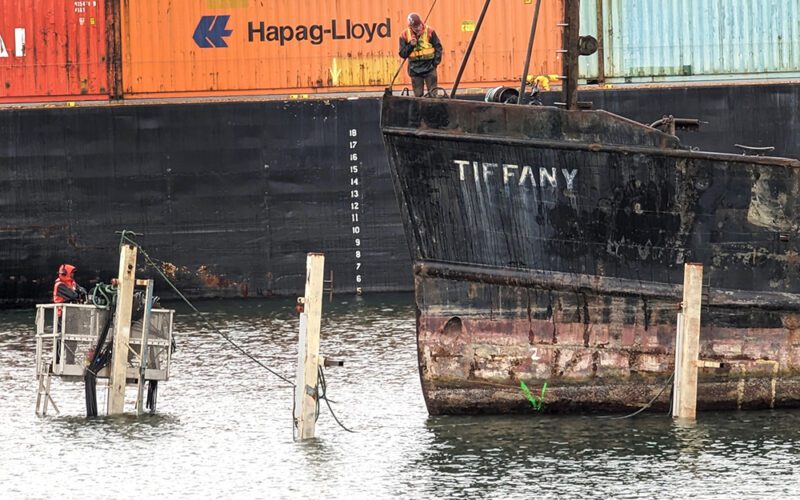
This past summer, a challenging environmental demolition project was put out for bid by Oregon’s Department of State Lands (DSL).
The scrapping of an 86-foot derelict hull named Tiffany was to be a demonstration project for the agency’s new program to remove a number of the state’s larger derelict vessels.
This required that the entire process meet strict standards to avoid any chance of oil or chemical spills.
The contract was won by Global Diving and Salvage of Seattle, with Astoria-based WCT Marine & Construction sub-contracting the floating assets to salvage the vessel and its secure onshore location to recycle it.
The proactive action was the direct result of the disastrous situation in Portland in the previous year, when the 15-year saga of two derelict military vessels over 100 feet long concluded with both sinking in the winter of 2021-22 on the south channel of the Columbia River.
This could have resulted in a serious oil spill in full view of the I-5 freeway if the Coast Guard had not already removed 2,000 gallons of diesel fuel and hazardous materials in 2020, using about $300,000 from the Oil Spill Liability Trust Fund.
No further action was taken until the ex-USCG cutter Alert, a 125-foot vessel that was built 1926, sank in November 2021. In April, 2022 its neighbor, the 100-foot former Navy yard tug Sakarissa (built 1943) also went down while the various concerned agencies were still working on a salvage plan.
Planning was complete in August, 2022, then the Tourist No. 2, a 100-foot wooden car ferry built in Astoria in 1926, sank within a few feet of the Astoria waterfront. The owner had left it untended with a For Sale sign, and moored adjacent to a piling field.
With the powerful current threatening to break it up, it was judged to need immediate salvage—so the Global Diving & Salvage team was brought in from Portland to the lower Columbia River where they decided to surround the wreck with a pontoon-boom. This allowed an excavator on a small barge to reach into the pool, break the hull down and retrieve the pieces.
Attention then returned to Portland where both partially-submerged hulks were refloated and moved to drydocks at two local shipyards for scrapping. The negative publicity and the cost of this work pushed the state legislature to pass Oregon House Bill 5029 establishing a revolving fund to clean up inland waterways and coastal harbors using a large settlement with chemical company Monsanto over historic water pollution.
“This exemplifies the broken dreams of many people,” Scott Smith, an emergency response planner with the Oregon Department of Environmental Quality (DEQ) said. “The Alert got into worse and worse condition where there is always at a risk of sinking.”
The DSL was given a two-year budget of nearly $19 million and made the Tiffany its first project. There was very little documentation about the boat, which was reportedly built before WWII as a buoy tender for the U.S. Light House Service, then converted into a fishing vessel about 50 years ago.
When the last owner gave up, the boat was abandoned on a backwater channel midway between Astoria and Portland. This was where it began its slow ‘voyage to nowhere.’ It became a dumping spot and homeless camp until Coast Guard and DSL teams were forced to clean up the interior and seal the entrances.
But it was broken into again and used for illegal activities until it capsized last winter while loaded with scrap steel, garbage, oil and unknown chemicals.
Chris Castelli, acting director of operations for the Department of State Lands, said hundreds of abandoned vessels have accumulated in bays, oceans, lakes and rivers across Oregon, posing a threat to both the environment and public safety.
“These (derelicts) contaminate water, they damage habitat, they damage the property—which is the public’s property—and they impede navigation,” he said. “Also, they impact the use and enjoyment of our waterways for the people of Oregon.”
The largest derelict ship on the lower Columbia River is believed to be the USS Washtenaw County, a nearly 400-foot-long Vietnam-era tank landing ship. The decommissioned military vessel is rusting with its hatches welded shut in a side channel downriver of the city of Rainier.
WCT provided its 50-ton crane barge Tongue Point and 90-foot push tug Voyager to right the Tiffany, secure it to the barge and haul it downriver to Tongue Point where it was floated onto a trailer and hauled straight into a 60 foot high and 150 foot long “tension fabric” structure known as the Big Top.
At this point, the Global team took over, using a reinforced excavator to handle the extreme loads imposed by demolition.
Within a week, the steel scrap, insulation and piping were all loaded into bins and trucked away to the recyclers. The tarmac on the newly-raised floor under the tent was swept and power washed.
The final cost exceeded $1.4 million, but proved that onshore disposal under cover is the safest and most efficient method of removing the fleet of derelicts on the Columbia and the notoriously rainy Pacific Northwest coast.

